Chant Yemanja (Goddess of the Sea)
Ago Lona O Ya Le –
Open the way for the most powerful mother
Ago Lona O Ya Le –
Open the way for the most powerful mother
Ya Le Ya Luma O –
Most able mother who protect children
Ya Le Omi Abe –
Mothers’ house of the deepest waters
A Ya Ba Omi O – Ruler of the great water– Yemanja, by Dianne Reeves
Buenos Aires – Dallas and Fort Worth busily debate the ethics of baggy pants bans, and the State of Missouri, where several municipalities have already passed such bans, has decided that they’re on a roll, and the legislature is facing a vote on whether or not to ban restaurants from serving fat people. Not as dishes, which would probably violate some trans-fat legislation that’s already in place, but as customers. Yes indeed, in our world where people need protecting from themselves, the State is considering turning restaurateurs into dietary enforcement agents, where they will have to make a judgment call as to whether an incoming potential customer is “obese” by local standards, and therefore not entitled to eat in a public space. The proposed law does not yet have any riders attached that will allow the gavage feeding of anorexics, which in hindsight is probably prohibited by anti-foie gras laws, nor the banning of bulemics from the use of restaurant bathrooms, but no doubt those are coming.
Meanwhile, here at Casa SaltShaker, I’m back from my little jaunt, though Henry is still away for a few weeks, and I got things up and running again this weekend with the help of a very willing, but very nervous friend who has never waited tables before. She did fine, and will continue to fill in for the upcoming week. First up on the agenda, the celebration of Yemanja, goddess of the seas, and one of the most important dieties of the Yoruba culture in Western Africa (and, via slave trade, Brazil). It seemed a perfect opportunity to pull out some West African cookbooks and do a little experimenting.
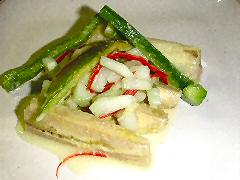 We started off with a Plantain Salad Imoyo… the latter word referring, as best I can gather to dishes (and culture?) created via the influence of returned slaves from Brazil – In the 15th century the Portuguese had brought many West Africans to Brazil to work for them, and in the 19th century, some returned to Africa, primarily coastal Nigeria, bringing with them various new ingredients and techniques. The salad is fairly simple to make, though taking a bit of time to prepare – step one being to completely peel the plantains, cut them into sections, and boil them in lightly salted water. If you’ve left any skin on them, it will turn black as it boils, don’t worry, it makes it easy to see and remove. Once the water comes to a boil, let it go for ten minutes, then drain and cool the plantain pieces. Cut them into thin wedges, and toss them with a julienne of green bell pepper, slivers of hot red chilies, and diced cucumber. Chill well. Make a dressing from several cloves of garlic, and roughly equal parts of fresh lime juice and olive oil, season with salt and pepper. Chill the dressing as well. When ready to serve, toss the vegetables with the dressing, and arrange reasonably nicely on plates. I paired this up with Callia’s Extra Brut 2007 sparkling – a mix of Chardonnay and Pinot Gris, from San Juan.
We started off with a Plantain Salad Imoyo… the latter word referring, as best I can gather to dishes (and culture?) created via the influence of returned slaves from Brazil – In the 15th century the Portuguese had brought many West Africans to Brazil to work for them, and in the 19th century, some returned to Africa, primarily coastal Nigeria, bringing with them various new ingredients and techniques. The salad is fairly simple to make, though taking a bit of time to prepare – step one being to completely peel the plantains, cut them into sections, and boil them in lightly salted water. If you’ve left any skin on them, it will turn black as it boils, don’t worry, it makes it easy to see and remove. Once the water comes to a boil, let it go for ten minutes, then drain and cool the plantain pieces. Cut them into thin wedges, and toss them with a julienne of green bell pepper, slivers of hot red chilies, and diced cucumber. Chill well. Make a dressing from several cloves of garlic, and roughly equal parts of fresh lime juice and olive oil, season with salt and pepper. Chill the dressing as well. When ready to serve, toss the vegetables with the dressing, and arrange reasonably nicely on plates. I paired this up with Callia’s Extra Brut 2007 sparkling – a mix of Chardonnay and Pinot Gris, from San Juan.
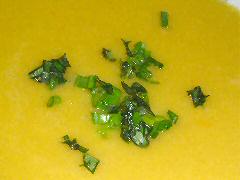 A classic soup of Nigeria, and in particular the Yoruba culture, is a peanut and yam based soup. I’ve seen versions with chopped vegetables in broth, and I’ve seen more cream style soups. I decided on the latter – saute a couple of onions with a good amount of chopped fresh ginger, and a couple of yellow hot chilies, in peanut oil. When the onions are starting to lightly caramelize, add a large, diced batata, or yam, and top off the soup with a good stock (traditional is probably chicken or fish stock, I used a vegetable stock). When the yam is soft, puree until smooth with one good sized tomato, and about a cup of smooth peanut butter (preferably not something commercial with salt and sugar added, but something you’d find at a natural foods store, or even just simply grind a cup or so of roasted (and unsalted) peanuts to a paste yourself. Season with salt and pepper. Garnish with chopped green onions and mint or basil (I used yerba buena which has a flavor somewhere between the two), and serve a good hot sauce on the side to add a kick – all of which paired nicely with La Flor de Pulenta Sauvignon Blanc 2007, my current favorite Sauvignon from Mendoza.
A classic soup of Nigeria, and in particular the Yoruba culture, is a peanut and yam based soup. I’ve seen versions with chopped vegetables in broth, and I’ve seen more cream style soups. I decided on the latter – saute a couple of onions with a good amount of chopped fresh ginger, and a couple of yellow hot chilies, in peanut oil. When the onions are starting to lightly caramelize, add a large, diced batata, or yam, and top off the soup with a good stock (traditional is probably chicken or fish stock, I used a vegetable stock). When the yam is soft, puree until smooth with one good sized tomato, and about a cup of smooth peanut butter (preferably not something commercial with salt and sugar added, but something you’d find at a natural foods store, or even just simply grind a cup or so of roasted (and unsalted) peanuts to a paste yourself. Season with salt and pepper. Garnish with chopped green onions and mint or basil (I used yerba buena which has a flavor somewhere between the two), and serve a good hot sauce on the side to add a kick – all of which paired nicely with La Flor de Pulenta Sauvignon Blanc 2007, my current favorite Sauvignon from Mendoza.
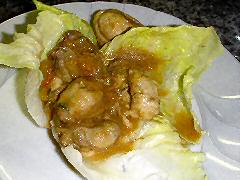 Who knew that “in the mangroves of West Africa, oysters are abundant and are the basis for a number of recipes from this region”, as cooks.com puts it? I pretty much didn’t change this recipe at all – it just sounded so good – I marinated the shucked oysters in a bath of fresh lemon juice with plenty of ancho chili and ginger powders for a couple of hours. Meanwhile I peeled and seeded some tomatoes, then pureed them. Cooked some diced onion in peanut oil until translucent, added the tomato puree, and simmered it down until most of the liquid was evaporated. Ten minutes before I was ready to serve the course, I drained the oysters, and then tossed them in a very hot, big pan, and cooked them for about five minutes, stirring regularly to prevent burning. They give off a lot of liquid… add the tomato paste mixture to them, and cook for another five minutes to combine the flavors. Season with salt and pepper, and yes, that is a leaf of iceberg lettuce (here called “capuchin”, after the cowls that capuchin monks wear) that I served them up on. The bit of a kick on the oysters (they’re not real spicy, though you can add hot sauce, or better yet, just use a hotter chili powder than ancho…), married up well with Callia Alta’s Rosado de Syrah 2007.
Who knew that “in the mangroves of West Africa, oysters are abundant and are the basis for a number of recipes from this region”, as cooks.com puts it? I pretty much didn’t change this recipe at all – it just sounded so good – I marinated the shucked oysters in a bath of fresh lemon juice with plenty of ancho chili and ginger powders for a couple of hours. Meanwhile I peeled and seeded some tomatoes, then pureed them. Cooked some diced onion in peanut oil until translucent, added the tomato puree, and simmered it down until most of the liquid was evaporated. Ten minutes before I was ready to serve the course, I drained the oysters, and then tossed them in a very hot, big pan, and cooked them for about five minutes, stirring regularly to prevent burning. They give off a lot of liquid… add the tomato paste mixture to them, and cook for another five minutes to combine the flavors. Season with salt and pepper, and yes, that is a leaf of iceberg lettuce (here called “capuchin”, after the cowls that capuchin monks wear) that I served them up on. The bit of a kick on the oysters (they’re not real spicy, though you can add hot sauce, or better yet, just use a hotter chili powder than ancho…), married up well with Callia Alta’s Rosado de Syrah 2007.
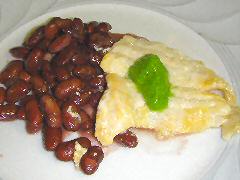 I have to tell you. I love coconut beans. I never had them before. I love them. Traditionally, they’re made mixed with brown rice, but I wanted just the beans – after all, the starches on this dinner were kind of adding up, no? I soaked red beans overnight in cold water, then cooked them in equal parts of coconut milk and water until they were nice and tender. Season with salt and pepper and you’re ready to go. The fish, lenguado, or sole, marinated for a couple of hours in a mix of condensed milk (not sweetened evaporated milk please), and passionfruit juice concentrate. Then the fish is baked, placed aside the beans, and topped with a dollop of a quick parsley “pesto” – which is really just a puree of parsley, olive oil, garlic, sunflower seeds, salt and pepper. As a good quaff on the side, Bodegas Chandon’s “Clos du Moulin” 2005, a blend of Pinot Noir and Cabernet, worked out brilliantly, if I do say so myself.
I have to tell you. I love coconut beans. I never had them before. I love them. Traditionally, they’re made mixed with brown rice, but I wanted just the beans – after all, the starches on this dinner were kind of adding up, no? I soaked red beans overnight in cold water, then cooked them in equal parts of coconut milk and water until they were nice and tender. Season with salt and pepper and you’re ready to go. The fish, lenguado, or sole, marinated for a couple of hours in a mix of condensed milk (not sweetened evaporated milk please), and passionfruit juice concentrate. Then the fish is baked, placed aside the beans, and topped with a dollop of a quick parsley “pesto” – which is really just a puree of parsley, olive oil, garlic, sunflower seeds, salt and pepper. As a good quaff on the side, Bodegas Chandon’s “Clos du Moulin” 2005, a blend of Pinot Noir and Cabernet, worked out brilliantly, if I do say so myself.
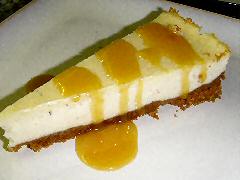 Finally, on to dessert – and I knew I wanted to do something with nutmeg, which seems to be one of the major spices in the region. I’d originally been thinking something with peaches, since as I discovered not so long ago, apparently peaches are a big thing in Western Africa, but one of our guests was allergic, so it was easier to create something else. I thought about a nutmeg pie, something I’ve made before and really liked, and in the end, decided to pair it up with a cheesecake and make a nutmeg cheesecake, which then gave way to thinking about something to top it with, and I decided to make a quick, warm, lime caramel sauce to drizzle over it. That worked. And even better with San Felipe’s Tardío 2005, a late harvest blend of Chardonnay, Gewurztraminer, and Semillon, from Mendoza.
Finally, on to dessert – and I knew I wanted to do something with nutmeg, which seems to be one of the major spices in the region. I’d originally been thinking something with peaches, since as I discovered not so long ago, apparently peaches are a big thing in Western Africa, but one of our guests was allergic, so it was easier to create something else. I thought about a nutmeg pie, something I’ve made before and really liked, and in the end, decided to pair it up with a cheesecake and make a nutmeg cheesecake, which then gave way to thinking about something to top it with, and I decided to make a quick, warm, lime caramel sauce to drizzle over it. That worked. And even better with San Felipe’s Tardío 2005, a late harvest blend of Chardonnay, Gewurztraminer, and Semillon, from Mendoza.
As always, looks like a kick-ass meal, especially the plantain salad. Do you happen to know, since I’ve never read it anywhere, how much nutmeg you can put into a dish before it becomes toxic? I always load up my bechamels with nutmeg, but no one has died yet!
I have to admit, I’d never thought of it, since I’d always heard that in order to reach levels where “nutmeg poisoning” might ensue it would taste so terrible no one would eat it anyway – turns out that’s probably pretty close – at least according to the figures on wikipedia, it takes an ingestion of greater than 25 grams at one time to be at risk for nutmeg poisoning (hallucinations, sense of impending doom, agitation), and greater than 30 grams for toxicity (convulsions, nausea, palpitations). Respectively, that’s 5 and 6 teaspoons full – for one person. I used one teaspoon for the entire cheesecake which produced a nice, mild nutmeg flavor – I doubt I’d have wanted much more than that or it would have just tasted too weird.
I have to make that soup! It looks delicious and totally satisfying. Thanks for posting it.
De nada, enjoy it! It’s probably even better as a cold weather soup than it was here, in mid-summer – but then again, I guess it never gets frozen and snowy in Nigeria…
Thanks for looking that up Dan, much appreciated. I only use 1 tsp. nutmeg in my bechamels – a lot more than most people, but it is a nice complement in my Moussaka.
I think I am going to have to try some sub-Saharan African dishes soon. Bring on the berbere….
[…] then I started thinking about the fish marinated in passionfruit juice and condensed milk from the previous week’s dinners, and it just seemed a natural match. I used fillets of abadejo, or pollack, cut nice and thick, and […]